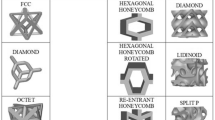Abstract
Structural lightweighting is a key initiative in the automotive sector due to regulatory, customer, and powertrain demands. This research focuses on reinforcing aluminum sheet metal in strategic locations using ultrasonic additive manufacturing (UAM), as guided through an iterative optimization and simulation process. Among the three models used, the most successful is the multi-step model (MSM) which simulates the forming of tailored blanks and the unloading processes to accurately map the hardening and the residual stress in hat and reinforcement sections. The MSM shows that approximately 65% of the mass can be saved by replacing a large gauged sheet metal hat section with a discretely reinforced hat section. Further increases in specific energy absorption (SEA) and additional mass savings can be expected when utilizing higher specific strength and specific stiffness materials for reinforcement such as titanium alloys, composites, or ceramic materials, all of which have been demonstrated with UAM.


















Similar content being viewed by others
References
Hahnlen R, Dapino MJ (2014) NiTi–Al interface strength in ultrasonic additive manufacturing composites. Compos Part B 59:101–108. https://doi.org/10.1016/j.compositesb.2013.10.024
Graff K (2005) 9 - Ultrasonic metal welding. In: Ahmed N (ed) New developments in advanced welding. Woodhead publishing, pp 241-269. https://doi.org/10.1533/9781845690892.241
Hopkins CD, Dapino MJ, Fernandez SA (2010) Statistical characterization of ultrasonic additive manufacturing Ti/Al composites. J Eng Mater Technol 132(4):041006-041006-041009. https://doi.org/10.1115/1.4002073
Haghdadi N, Laleh M, Moyle M, Primig S (2021) Additive manufacturing of steels: a review of achievements and challenges. J Mater Sci 56(1):64–107. https://doi.org/10.1007/s10853-020-05109-0
Sridharan N, Norfolk M, Babu SS (2016) Characterization of steel-ta dissimilar metal builds made using very high power ultrasonic additive manufacturing (VHP-UAM). Metall Mater Trans A 47(5):2517–2528. https://doi.org/10.1007/s11661-016-3354-5
Sridharan N, Wolcott P, Dapino M, Babu SS (2017) Microstructure and mechanical property characterisation of aluminium–steel joints fabricated using ultrasonic additive manufacturing. Sci Technol Weld Join 22(5):373–380. https://doi.org/10.1080/13621718.2016.1249644
Truog AG (2012) Bond improvement of Al/cu joints created by very high power ultrasonic additive manufacturing. The Ohio State University
Gordon BL, Norfolk M (2015) Selective reinforcement using metal matrix composite and ultrasonic additive manufacturing. In: SAMPE 2015, Baltimore MD, May 19–20 / 2015
Hehr A, Wenning J, Norfolk M, Sheridan J, Newman JA, Domack M (2019) Selective reinforcement of aerospace structures using ultrasonic additive manufacturing. J Mater Eng Perform 28(2):633–640. https://doi.org/10.1007/s11665-018-3614-1
Guo H, Gingerich MB, Headings LM, Hahnlen R, Dapino MJ (2019) Joining of carbon fiber and aluminum using ultrasonic additive manufacturing (UAM). Compos Struct 208:180–188. https://doi.org/10.1016/j.compstruct.2018.10.004
Ashby MF (2011) Chapter 5 - materials selection—the basics. In: Ashby MF (ed) Materials selection in mechanical design, Fourth edn. Butterworth-Heinemann, Oxford, pp 97–124. https://doi.org/10.1016/B978-1-85617-663-7.00005-9
Zamiri A, Pourboghrat F (2007) Characterization and development of an evolutionary yield function for the superconducting niobium sheet. Int J Solids Struct 44(25):8627–8647. https://doi.org/10.1016/j.ijsolstr.2007.06.025
Park T, Abu-Farha F, Pourboghrat F (2019) An evolutionary yield function model based on plastic work and non-associated flow rule. Metals 9(5):611
Li KP, Carden WP, Wagoner RH (2002) Simulation of springback. Int J Mech Sci 44(1):103–122. https://doi.org/10.1016/S0020-7403(01)00083-2
Moon YH, Kang SS, Cho JR, Kim TG (2003) Effect of tool temperature on the reduction of the springback of aluminum sheets. J Mater Process Technol 132(1):365–368. https://doi.org/10.1016/S0924-0136(02)00925-1
Yoon J-W, Pourboghrat F, Chung K, Yang D-Y (2002) Springback prediction for sheet metal forming process using a 3D hybrid membrane/shell method. Int J Mech Sci 44(10):2133–2153. https://doi.org/10.1016/S0020-7403(02)00165-0
Pourboghrat F, Karabin ME, Becker RC, Chung K (2000) A hybrid membrane/shell method for calculating springback of anisotropic sheet metals undergoing axisymmetric loading. Int J Plast 16(6):677–700. https://doi.org/10.1016/S0749-6419(99)00067-4
Gomes C, Onipede O, Lovell M (2005) Investigation of springback in high strength anisotropic steels. J Mater Process Technol 159(1):91–98. https://doi.org/10.1016/j.jmatprotec.2004.04.423
Hooputra H, Gese H, Dell H, Werner H (2004) A comprehensive failure model for crashworthiness simulation of aluminium extrusions. International Journal of Crashworthiness 9(5):449–464. https://doi.org/10.1533/ijcr.2004.0289
Smith M (2016) Abaqus analysis user's guide, version 2016. Simulia, Providence, RI
Acknowledgments
The authors would like to acknowledge and thank Honda R&D Americas, LLC for the support of this research.
Author information
Authors and Affiliations
Corresponding authors
Ethics declarations
Conflict of interest
The authors declare that they have no conflict of interest.
Additional information
Publisher’s note
Springer Nature remains neutral with regard to jurisdictional claims in published maps and institutional affiliations.
Rights and permissions
About this article
Cite this article
Ahn, H., Gingerich, M.B., Hahnlen, R. et al. Numerical modeling of mechanical properties of UAM reinforced aluminum hat sections for automotive applications. Int J Mater Form 14, 917–928 (2021). https://doi.org/10.1007/s12289-020-01607-3
Received:
Accepted:
Published:
Issue Date:
DOI: https://doi.org/10.1007/s12289-020-01607-3




